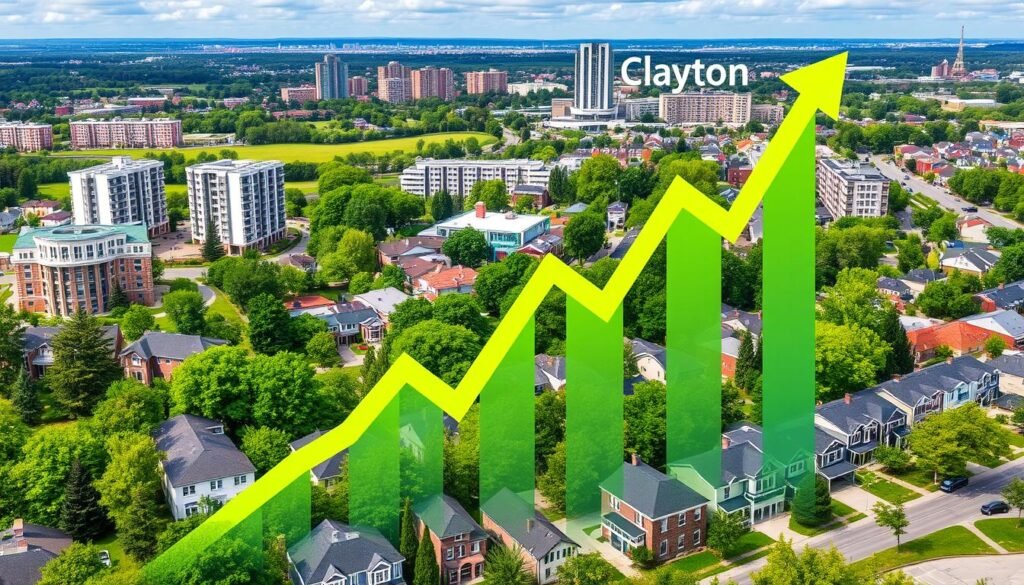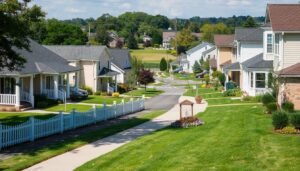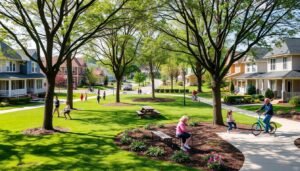Thinking about buying a home or investing in Clayton? Ever wondered what affects property prices here? From the median house price of $1,184,444 to the average 30 days on the market, knowing what drives the local market is key.
In this detailed article, we explore the economic, location, and demographic factors that influence Clayton’s property prices. Whether you’re looking to buy a house or a unit, this analysis will help you understand the local real estate better.
Key Takeaways
- Clayton has a total of 142 houses and 336 units available for sale.
- The median house price is $1,184,444 with -4.48% annual capital growth, while the median unit price is $749,000 with 2.88% annual growth.
- Houses in Clayton spend an average of 30 days on the market, while units spend 44 days.
- Rental yields for houses are 2.74% with a median weekly rent of $600, while units yield 4.68% with a median weekly rent of $550.
- Clayton’s population growth rate from 2011 to 2016 was 24.5%, with the predominant age group being 20-29 years old.
Economic Trends and Their Impact on Property Values
The property market in Clayton is shaped by many factors. These include the current economic conditions, the job market, and interest rates. These elements greatly affect property values, guiding the choices of buyers and sellers.
Current Economic Conditions
In Clayton, the property market has seen mixed trends. Houses have seen a -4.48% annual growth, while units have grown by 2.88%. This shows that different types of properties are affected differently by the economy.
The median household income in Clayton has grown from $952 to $1,054 per week. This is a 10.71% increase over five years. Such economic growth can boost property values and borrowing capacity, increasing demand for homes.
Job Market Influences
The local job market’s strength significantly impacts Clayton’s property values. A robust job market boosts housing demand as more people can afford to buy. On the other hand, high unemployment or slow job growth can lower demand and prices.
Interest Rates and Borrowing Costs
Interest rates and borrowing costs are key to property affordability. Low interest rates make borrowing easier, potentially increasing demand and property values. But, rising rates can make financing harder, slowing the market and affecting prices.
As the economy changes, it’s crucial for Clayton’s buyers and investors to watch these factors. They influence the local property market greatly.
| Indicator | Clayton | National Average |
|---|---|---|
| House Price Growth | -4.48% annual | 2.1% annual |
| Unit Price Growth | 2.88% annual | 3.5% annual |
| Median Household Income | $1,054 per week | $1,172 per week |
| Unemployment Rate | 5.2% | 4.9% |
| Interest Rates | 4.5% | 4.0% |
Location Specifics in Clayton
Clayton is a suburb in Victoria’s heart, known for its prime location. It covers about 7.9 square kilometres. This vibrant area offers many benefits that can affect property prices.
Proximity to Public Transport
Clayton’s great location is thanks to its public transport access. The Clayton railway station connects to Melbourne’s CBD and other major spots. Bus routes also cover the area, making it easy for residents to get around.
Access to Amenities and Services
Clayton has a wide range of amenities and services. It has shopping centres, restaurants, cafes, and recreational spots. This makes it a convenient and self-sufficient place to live. Healthcare services are also nearby, so residents don’t have to travel far.
Educational Institutions Nearby
Clayton is home to Monash University, one of Australia’s largest universities. This attracts many students. The demand for housing from students can impact property prices in the area.
Clayton’s location, transport, amenities, and education links make it a sought-after suburb. These factors are key in shaping the local property market and home values.
Infrastructure Developments
The city of Clayton is growing, and the local government is investing in new projects. These projects aim to make the community better and more attractive. This is great news for both current and future homeowners.
Future Urban Planning and Development Projects
The Clayton City Council has big plans for the area. They want to make the city centre better with new shops, parks, and homes. This will make Clayton a more lively and connected place for everyone.
Transportation Upgrades
The local authorities are working on better transport. They plan to add more buses and might even bring in light rail. They also want to make roads better to reduce traffic jams.
Community Facilities Enhancements
The government is also improving community spaces. They aim to upgrade parks, sports areas, and centres. New schools and health facilities are also on the way. These changes will make Clayton a better place to live.
These projects will make Clayton more vibrant and desirable. Property values are likely to rise, offering both chances and challenges for homeowners and investors.
| Infrastructure Upgrade | Timeline | Estimated Cost |
|---|---|---|
| City Centre Revitalisation | 2023 – 2027 | $150 million |
| Transportation Network Expansion | 2024 – 2028 | $85 million |
| Community Facilities Enhancement | 2025 – 2029 | $65 million |
Demographics of Clayton’s Population
Clayton is changing fast, and its people are key to this change. Looking at who lives here and how much they earn helps us understand property prices. This insight is crucial for the suburb’s growth.
Population Growth and Its Effects
Clayton’s population has jumped from 15,543 in 2011 to 19,348 in 2016. That’s a 24.5% increase. This growth means more people want to live here, pushing up property prices.
Age Distribution Trends
- The main age group in Clayton is 20-29 years, showing a young community.
- This age group, full of young professionals and first-time buyers, wants smaller, cheaper homes like apartments.
- Younger residents also attract more businesses and services, drawing in more investors and buyers.
Income Levels and Purchasing Power
Clayton’s median household income has grown from $952 per week in 2011 to $1,054 in 2016. This 10.71% rise means people can afford more, driving demand for better homes.
The changes in Clayton’s population, including more people, a younger age, and higher incomes, shape the suburb. These changes affect what homes are in demand, prices, and investment opportunities. Clayton is a lively place for both those buying homes and investing in property.
Historical Property Price Trends
Clayton, a suburb in Melbourne, has seen different trends in its property market. House prices have slightly dropped by -4.48% each year. But, unit prices have grown by 2.88% annually.
Analysis of Past Growth Rates
Looking closer, we see houses in Clayton growing by 0.38% every quarter. Units have seen a bigger jump of 4.98% in the same time. Houses have seen an average annual growth of -0.28%. Units, on the other hand, have grown by 6.32% each year.
Market Resilience During Economic Downturns
Clayton’s market has shown strength even when the economy is down. House prices may drop short-term, but the market usually bounces back. This shows Clayton’s long-term stability and appeal.
This resilience comes from several factors. These include its good transport links, access to amenities, and top schools.
| Property Type | Annual Growth Rate | Quarterly Growth Rate | Average Annual Growth |
|---|---|---|---|
| Houses | -4.48% | 0.38% | -0.28% |
| Units | 2.88% | 4.98% | 6.32% |
This detailed analysis gives us a clear view of Clayton’s property trends. The house market has softened, but units are growing strongly. This makes Clayton a great choice for buyers and investors.
Local Government Policies
When looking to buy or invest in property in Clayton, knowing about local government policies is key. These policies, including zoning laws and property taxes, shape the area’s property prices. They can make properties more attractive or harder to afford.
Zoning Laws and Regulations
The local council’s zoning laws and development controls are crucial. They decide what types of homes can be built where. These rules can change how many homes are built and where, affecting prices.
Keeping up with the council’s plans and zoning changes is important. It helps you make better investment choices.
Incentives for Property Buyers
Local governments offer incentives to attract buyers. These can be stamp duty breaks, first-home grants, or other financial help. Knowing about these incentives can make properties more affordable in Clayton.
Property Taxes and Charges
Property taxes and charges, like council rates, add to the cost of owning a home in Clayton. Understanding these taxes and any changes can help you decide if investing is right for you.
Staying informed about local policies can help you make smart choices in Clayton’s real estate market.
Market Demand and Supply Dynamics
The real estate market in Clayton is a delicate balance of market demand and supply. The area has 142 houses and 336 units for sale. Houses average 30 days on the market, while units take 44 days.
This shows a lively market with different demand for houses and units.
Buyer Preferences and Trends
Understanding buyer preferences and trends is key to grasping Clayton’s property market. Population growth, income levels, and demographic shifts influence these preferences. Investors and first-home buyers have different needs.
- Younger buyers look for modern, easy-to-maintain units near transport and amenities.
- Families want spacious single-family homes near good schools and community facilities.
- Investors seek properties with high rental yields and growth potential.
Inventory Levels in Clayton
Inventory levels in Clayton offer insights into the market’s balance. The data shows a balanced market, with houses and units being sold at different rates. New developments, zoning rules, and economic conditions can change inventory levels.
| Property Type | Available Inventory | Average Days on Market |
|---|---|---|
| Houses | 142 | 30 |
| Units | 336 | 44 |
By watching market demand, supply, preferences, and inventory, real estate professionals in Clayton can make smart choices. This helps them navigate the market better.
The Role of Real Estate Agents
In Clayton’s fast-changing property market, real estate agents play a key role. They know the local market inside out. They use their networks and smart marketing to help buyers and sellers.
Agent Networks and Market Knowledge
Real estate agents in Clayton have strong connections in the industry. They have access to lots of information about the local market. This includes the latest sales data, price trends, and what buyers like.
Marketing Strategies Employed
Marketing is a big part of what real estate agents do. In Clayton, they use many strategies to promote properties. This includes ads, setting the right prices, hosting open houses, and using online platforms.
Agents in Clayton are crucial in setting property values and making them desirable. They use their knowledge to help clients make smart choices. This way, clients can meet their investment goals.
| Service | Typical Cost |
|---|---|
| Property Management Fees | 5% to 12% of weekly rent |
| Rental Commission | 7.66% of weekly rent |
| Letting Fees | 1-2 weeks’ rent |
| Lease Renewal Fees | 1 week’s rent or flat-rate |
| Marketing Costs | $300 to $1,500 for photography and videography |
| Real Estate Agent Commission | 1.8% to 3.5% in Sydney, 5% on first $18,000 then 2.5% in Brisbane, around 2.4% in Melbourne |
The table shows typical costs for real estate services in Australia. This includes fees for property management, rentals, and agent commissions. These costs can change based on location, property type, and market conditions. But they give a general idea of what to expect in Clayton.
“Real estate agents in Clayton are not only well-versed in the local market but also adept at crafting marketing strategies that can significantly impact property values and sales outcomes.”
Property Types and Their Influence
In Clayton, the real estate market shows different trends for single-family homes and units. Knowing these trends helps both buyers and investors make informed choices.
Single-Family Homes vs. Units
Single-family homes in Clayton cost a median of $1,184,444, with a yearly drop of -4.48%. Units, on the other hand, have a median price of $749,000 and a yearly growth of 2.88%. This makes units a more appealing choice for those looking for value and growth.
But the rental market shows a different story. Single-family homes offer a 2.74% rental yield, while units provide a 4.68% yield. This shows units are better for investors aiming for rental income and cash flow.
New vs. Established Properties
- New properties in Clayton are often more expensive due to their modern features and amenities. They appeal to young families and first-time buyers.
- Established properties, though, offer better value and the chance to renovate or add personal touches. They’re great for those wanting a unique or customised home.
The choice between single-family homes and units, or new and established properties, depends on personal preferences, budget, and investment goals. Understanding the local market helps make the right choice for your needs.
| Property Type | Median Price | Annual Growth Rate | Rental Yield |
|---|---|---|---|
| Single-Family Homes | $1,184,444 | -4.48% | 2.74% |
| Units | $749,000 | 2.88% | 4.68% |
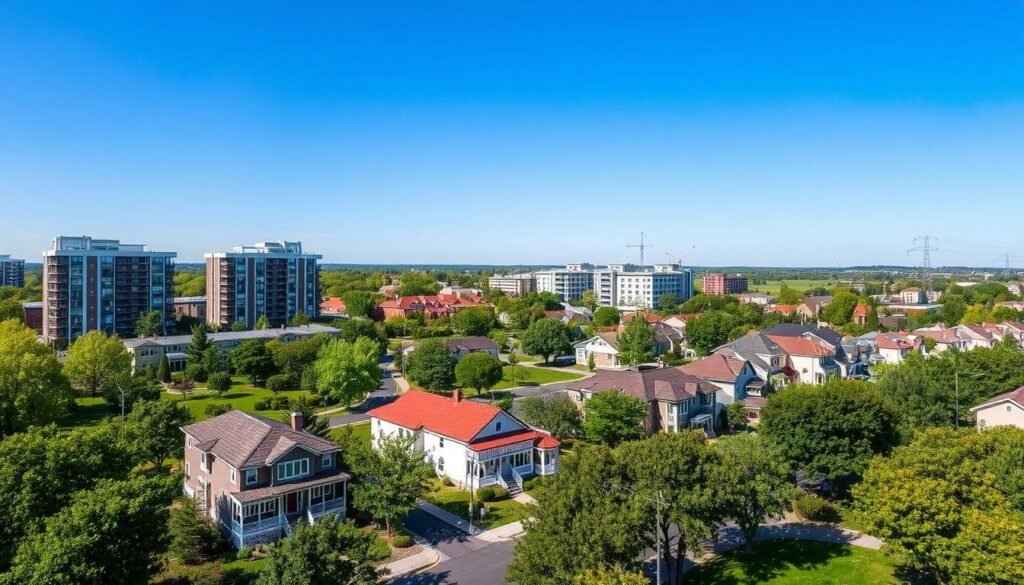
Environmental Considerations
Environmental factors greatly affect property prices in Clayton. The area has 9 parks covering nearly 4.1% of the land. This green space makes Clayton more appealing and might boost property values. Yet, the exact effect of green spaces on prices needs more study.
Green spaces are a plus, but natural disasters like bushfires and floods are a concern. These risks can affect property prices in the short and long term. Buyers and investors will consider these dangers when looking at properties in Clayton.
Natural Disaster Risks
Natural disasters in Clayton shape the local property market. Events like floods or bushfires raise buyers’ risk perception. This can influence their decision to buy in certain areas. Insurance costs and long-term environmental damage on property values are also important.
Green Spaces and Environmental Quality
Clayton’s green spaces are a big plus for the area. Studies show that living near parks can increase property prices by up to 20%. But, the exact effect of these spaces on Clayton’s real estate needs more detailed analysis.
The environmental factors in Clayton are complex. There are both good and bad aspects. Understanding how green spaces, natural disasters, and their combined effect on property prices is key for those in the Clayton real estate market.
“The real estate industry is in the early stages of incorporating heightened climate risk into investment and valuation processes, which suggests a lack of consensus on valuation standards regarding climate risks.”
Seasonal Changes in the Property Market
The property market in Clayton, like many other places, sees big changes with the seasons. These changes affect demand, prices, and how long homes stay on the market. It’s key for buyers, sellers, and real estate pros to know these trends.
Impact of Seasonal Demand Fluctuations
Seasonal shifts in what people want and feel can really change the Clayton property market. When it’s warm, from spring to early autumn, more people want to buy homes. This is because families might move before school starts, or people like the nice weather for looking at homes.
But when it gets cooler, from late autumn to early spring, things slow down. Fewer people want to buy, and there’s less interest in selling. This is because of the holidays, less economic activity, and cooler weather. These changes can affect how much homes cost and how long they’re on the market.
| Seasonal Period | Demand Trend | Price Impact | Average Market Time |
|---|---|---|---|
| Spring to Early Autumn | Increased Buyer Activity | Upward Pressure on Prices | Shorter Market Times |
| Late Autumn to Early Spring | Decreased Buyer Activity | Downward Pressure on Prices | Longer Market Times |
These seasonal changes in the property market really matter for buyers and sellers in Clayton. Knowing and adjusting to these patterns can help make real estate deals better and more successful.
Foreign Investment in Clayton
Clayton, near top schools, has caught the eye of global property investors. Foreign investment is shaping local property prices. The arrival of international buyers looking for places to live or invest has changed the area’s homes market.
Trends in International Buyers
Recently, Clayton has seen more foreign buyers. This is due to:
- Its close link to big universities, drawing in international students and their families
- Interest from Asian investors, mainly from China, wanting to spread their investments
- Good exchange rates and stable politics and economy in Australia, making it a great place to invest
Effects of Foreign Ownership on Local Prices
The rise in foreign investment in Clayton has pushed up property prices. The demand from international buyers has made homes more expensive. This makes it harder for locals to buy their first home.
But, foreign investment also brings benefits like more jobs and economic growth. The key is to balance foreign money with local housing needs.

As Clayton’s property market grows, it’s crucial to watch how foreign investment affects things. We need to find ways to handle the issues with international buyers and property prices.
Economic Policies Related to Housing
Government policies and initiatives have a big impact on housing in Clayton. They affect how affordable and accessible homes are. This includes first home buyer grants and support for homeownership.
First Home Buyer Grants
The Australian government helps first-time home buyers with grants and incentives. The First Home Buyer Grant gives eligible buyers a payment for their first home. The amount varies by state, but it helps young Australians start their property journey.
Government Schemes Supporting Homeownership
There are more government schemes to help with home ownership. These include low-deposit loans, stamp duty discounts, and tax credits. They help with saving for a deposit and covering upfront costs.
While it’s hard to say exactly how these policies affect Clayton’s property prices, they do play a part. Policymakers need to keep an eye on how well these initiatives work. This helps ensure housing is affordable and fair for everyone.
Community Factors
When looking to buy or invest in Clayton, it’s key to know how community factors affect property prices. Things like local events and safety can really change how much people want to live in a place. These factors can make a big difference in how desirable and valuable a neighbourhood is.
Local Events and Community Spirit
Clayton is full of life, thanks to its many local events. These events help people feel connected and proud of where they live. From festivals to community meetings, these activities build a strong sense of community. Homes in areas with lots of events are often in high demand, as people want to be part of the local scene.
Safety and Crime Rates
Safety is another big factor in Clayton’s property prices. Areas that are safe and have low crime rates are more appealing. Studies show that many families in Clayton have kids, making safety a top priority for them. Homes in safer areas usually cost more because people are willing to pay extra for peace of mind and a better quality of life.
In summary, knowing about community factors like events and safety is vital when looking at property prices in Clayton. These aspects can greatly influence how desirable and valuable a neighbourhood is. They play a big role in what homebuyers and investors decide to do.
Future Predictions and Trends
Exploring the Clayton real estate market? It’s vital to look at future trends and predictions. Recent data shows mixed results, with houses dropping by -4.48% and units rising by 2.88%. But, Clayton’s growing population could drive demand higher in the future.
Forecasting Property Values in the Coming Years
Clayton’s population grew by 24.5% from 2011 to 2016. This could lead to more demand for properties. Yet, the economy and new infrastructure will also shape property values.
Influential Trends to Watch
Investors and buyers should keep an eye on trends affecting property value forecasts and future trends in Clayton real estate. Watch for population growth, job stability, and infrastructure projects. These can make Clayton more appealing and valuable.
FAQ
What are the key factors that influence property prices in Clayton?
How have the economic conditions in Clayton affected property values?
How does the location of Clayton impact its property prices?
What infrastructure developments in Clayton are expected to impact property prices?
How have the demographic changes in Clayton’s population affected the property market?
What are the historical property price trends in Clayton?
How do local government policies affect property prices in Clayton?
What are the market demand and supply dynamics for property in Clayton?
How do real estate agents impact the property market in Clayton?
How do different property types and their characteristics affect prices in Clayton?
FAQ
What are the key factors that influence property prices in Clayton?
Property prices in Clayton are influenced by several factors. These include the location, type of property, and nearby amenities. Infrastructure, economic conditions, and demographic changes also play a role. Government policies are another key factor.
How have the economic conditions in Clayton affected property values?
Economic conditions in Clayton have greatly impacted property values. The job market, income levels, and interest rates are all important. For example, a 10.71% increase in median household income from 2011 to 2016 has boosted demand and borrowing capacity.
How does the location of Clayton impact its property prices?
Clayton’s location is a big factor in property prices. Being close to public transport and amenities is attractive. The presence of educational institutions also adds to the suburb’s appeal.
What infrastructure developments in Clayton are expected to impact property prices?
Upcoming infrastructure projects in Clayton will likely affect property prices. These include urban planning, transportation upgrades, and community facility enhancements. These developments will make the area more desirable.
How have the demographic changes in Clayton’s population affected the property market?
Clayton’s population has grown by 24.5% between 2011 and 2016. The age group of 20-29 years is predominant. This growth may continue to influence property values in the future.
What are the historical property price trends in Clayton?
Clayton’s property market has shown different trends for houses and units. Houses have seen -4.48% annual growth, while units have grown by 2.88%. The average annual growth for houses is -0.28%, and units have seen a stronger 6.32% growth.
How do local government policies affect property prices in Clayton?
Local government policies have a significant impact on Clayton’s property market. Zoning laws, buyer incentives, and property taxes can make investing more attractive.
What are the market demand and supply dynamics for property in Clayton?
Clayton has 142 houses and 336 units for sale. Houses average 30 days on the market, and units average 44 days. This suggests a lively market with varied demand for different properties.
How do real estate agents impact the property market in Clayton?
Real estate agents in Clayton are crucial to the market. They use their networks, knowledge, and marketing to influence prices and sales outcomes.
How do different property types and their characteristics affect prices in Clayton?
Clayton’s property market shows mixed trends. Houses have a median price of
FAQ
What are the key factors that influence property prices in Clayton?
Property prices in Clayton are influenced by several factors. These include the location, type of property, and nearby amenities. Infrastructure, economic conditions, and demographic changes also play a role. Government policies are another key factor.
How have the economic conditions in Clayton affected property values?
Economic conditions in Clayton have greatly impacted property values. The job market, income levels, and interest rates are all important. For example, a 10.71% increase in median household income from 2011 to 2016 has boosted demand and borrowing capacity.
How does the location of Clayton impact its property prices?
Clayton’s location is a big factor in property prices. Being close to public transport and amenities is attractive. The presence of educational institutions also adds to the suburb’s appeal.
What infrastructure developments in Clayton are expected to impact property prices?
Upcoming infrastructure projects in Clayton will likely affect property prices. These include urban planning, transportation upgrades, and community facility enhancements. These developments will make the area more desirable.
How have the demographic changes in Clayton’s population affected the property market?
Clayton’s population has grown by 24.5% between 2011 and 2016. The age group of 20-29 years is predominant. This growth may continue to influence property values in the future.
What are the historical property price trends in Clayton?
Clayton’s property market has shown different trends for houses and units. Houses have seen -4.48% annual growth, while units have grown by 2.88%. The average annual growth for houses is -0.28%, and units have seen a stronger 6.32% growth.
How do local government policies affect property prices in Clayton?
Local government policies have a significant impact on Clayton’s property market. Zoning laws, buyer incentives, and property taxes can make investing more attractive.
What are the market demand and supply dynamics for property in Clayton?
Clayton has 142 houses and 336 units for sale. Houses average 30 days on the market, and units average 44 days. This suggests a lively market with varied demand for different properties.
How do real estate agents impact the property market in Clayton?
Real estate agents in Clayton are crucial to the market. They use their networks, knowledge, and marketing to influence prices and sales outcomes.
How do different property types and their characteristics affect prices in Clayton?
Clayton’s property market shows mixed trends. Houses have a median price of $1,184,444, and units are at $749,000. Houses have seen -4.48% annual growth, while units have grown by 2.88%. Rental yields also vary, with houses at 2.74% and units at 4.68%.
,184,444, and units are at 9,000. Houses have seen -4.48% annual growth, while units have grown by 2.88%. Rental yields also vary, with houses at 2.74% and units at 4.68%.
